Crowd Control Methods: Effective Strategies & Tools for Safe Events
Updated On: October 26, 2025 by Aaron Connolly
Core Principles of Crowd Control
If you want to run a safe event, you really need to know the difference between reactive crowd control and proactive crowd management. Every choice should have a clear safety goal, but honestly, you can’t ignore the experience side either.
These basics help event organisers keep things secure without killing the fun.
Differences Between Crowd Control and Crowd Management
Crowd management is all about staying ahead of problems. We plan, we design safe layouts, we train staff, and we try to make sure things never get out of hand in the first place.
Organisers use crowd management to guide people smoothly through venues, making the journey as painless as possible.
Crowd control jumps in when things get dicey. If a situation turns chaotic, that’s when we pull out the barriers, dispersal methods, and emergency procedures.
Police and security usually take over crowd control when regular plans aren’t enough.
| Crowd Management | Crowd Control |
|---|---|
| Prevents problems | Responds to problems |
| Plans ahead | Acts during incidents |
| Focuses on comfort | Focuses on safety |
| Used throughout events | Used during emergencies |
Timing makes all the difference here. Management happens before and during smooth operations. Control only steps in when things start to unravel.
Key Objectives for Effective Crowd Management
Safety always comes first. We do our best to protect people from injuries, stampedes, or overcrowding.
Organisers plan escape routes and make sure emergency services can reach every corner. Clear sight lines let security spot issues early.
Smooth flow keeps everyone moving. We design paths that avoid bottlenecks at entrances, exits, and hot spots.
Queue management cuts down on wait times and stress. Digital signs and mobile apps help steer folks in the right direction.
Communication connects us with the crowd in real time. Public address systems, screens, and radios build a fast information web.
Clear announcements help avoid panic. Regular updates let people know about schedule changes or safety concerns.
Foundational Concepts
Crowd density drives our choices. Light crowds? Just need signs and a few staff.
Dense crowds? We bring in barriers, extra exits, and nonstop monitoring. We measure density by people per square metre to decide what’s safe.
Predicting behaviour is a big deal. Sports fans, concert-goers, protesters—they all act differently.
We use advanced simulation software to see how people might move. It helps us spot trouble spots before doors even open.
Legal rules shape every crowd control method. We have to follow local laws, court orders, and safety codes.
Training makes sure security staff know the right way to handle things, including when and how to use force. Good documentation protects organisers and helps us improve next time.
Tech tools boost our old-school methods. Cameras, crowd monitoring apps, and real-time data help teams react fast to new problems.
Understanding Crowd Dynamics
People in groups follow patterns, and honestly, we can predict a lot of it. Crowd density, movement, and formation all shape how safe things stay and how well security can jump in.
Formation and Types of Crowds
Crowds come together for all kinds of reasons. Each type gives organisers its own set of headaches.
Active crowds show up on purpose. Sports fans, concert-goers, protesters—they’re fired up and focused.
Passive crowds just happen. Train delays, long lines, street accidents—no one wants to be there, but here they are.
Expressive crowds gather to share feelings. Festivals and celebrations bring people together just to enjoy the vibe.
How crowds form matters, too. Gradual build-up lets organisers tweak barriers and move staff around.
Sudden formation—think emergencies or surprise announcements—can put instant pressure on certain spots.
At gaming tournaments, you might see a chill crowd suddenly turn wild during finals. That passive-to-active shift? It happens fast.
Factors Affecting Crowd Behaviour
Crowd density changes everything. Once you hit four or five people per square metre, injury risks really spike.
Physical space shapes what people do:
- Wide areas let people spread out
- Narrow halls cause bottlenecks and shoving
- Bad lighting makes people anxious or confused
- Visible exits keep folks calmer
The environment matters. Heat makes people cranky. Rain packs everyone under cover. Loud noises can trigger panic.
Time pressure pushes crowds, too. Late arrivals rush. Delays make people restless. Timely info helps people plan.
Social vibes spread fast. One panicked person can set off hundreds. But a calm leader can chill out a crowd just as quickly.
Psychological Elements in Crowds
People think differently in crowds. Deindividuation means people lose their sense of self in a big group.
Emotional contagion spreads feelings in a flash. Excitement can electrify a concert. Fear jumps from person to person in emergencies. Joy multiplies at celebrations.
Social proof is powerful. Folks look around to see what’s normal. If everyone starts pushing, individuals join in.
Responsibility drops in a crowd. People do things they’d never do alone because they feel invisible.
Knowing these patterns helps us manage crowds better. Strong leadership, visible staff, and calm communication help balance out the negative side of group psychology.
We use these insights to spot trouble before it starts and put resources where they’re needed.
Risk Assessment and Event Planning
Risk assessments really are the backbone of safe esports events. They help organisers see trouble spots before anyone arrives and build safety into every part of the plan.
Conducting a Thorough Risk Assessment
We can’t just wing it based on past experience. A real risk assessment digs into every corner of your venue and event setup.
Start with the basics:
- What’s the max safe capacity?
- How many exits, and can everyone get to them?
- Are the electrical systems up to snuff for gaming gear?
- Where’s the food and drink happening?
You need input from a bunch of experts. Bring in security pros, venue managers, and emergency services early.
Key areas to check:
| Risk Category | Specific Concerns |
|---|---|
| Crowd density | Queue areas, main stage viewing zones |
| Technical failures | Power outages, internet connectivity |
| Medical emergencies | Player health, spectator incidents |
| Security threats | Unauthorised access, equipment theft |
Write everything down. Every risk gets a likelihood rating, a possible impact level, and a plan for handling it. It’s not just paperwork—it’s your game plan.
Identifying Bottlenecks and High-Risk Areas
Bottlenecks at esports events almost always pop up in the same places. Entry points, food stands, and bathrooms during breaks are the big ones.
Common trouble spots:
- Registration and credential pickup
- Merch stalls during rushes
- Player warm-up areas
- VIP meet-and-greet zones
Map out how people will move in your venue before the event. Think about how traffic shifts as the tournament heats up. Finals bring in the biggest crowds, so plan for that.
Gaming venues have their own quirks. Fans might carry pricey laptops or gear, and they often stick in their seats for hours, so bathroom and snack rushes hit differently.
Quick tip: If you can, walk the venue during a similar event. Snap photos of where people bunch up or where hallways get tight.
Station staff at key points to watch crowd density in real time. Make sure they can report problems fast.
Integration with Event Planning Processes
Risk assessments have to tie right into your event planning schedule and budget. Safety touches everything, from vendor deals to marketing.
Timeline ideas:
- 8-12 weeks out: Do your first risk assessment
- 4-6 weeks out: Lock in your crowd management plans
- 1 week out: Brief all staff on safety steps
- Event day: Keep monitoring systems running
Budget for safety from the start. You can’t skimp on extra security, barriers, or medical coverage—they’re just as important as the games.
Review risk assessments with every major supplier. Catering needs to know the crowd flow. AV techs have to understand emergency plans that could affect their gear.
Heads up: Risk assessment isn’t a “set it and forget it” job. Update your plans as ticket sales roll in and you get a real sense of attendance.
Set up clear steps for handling safety incidents. Every staffer should know who calls the shots if crowd control is needed. Fast action keeps small problems from becoming big disasters.
Physical Barriers and Venue Layouts
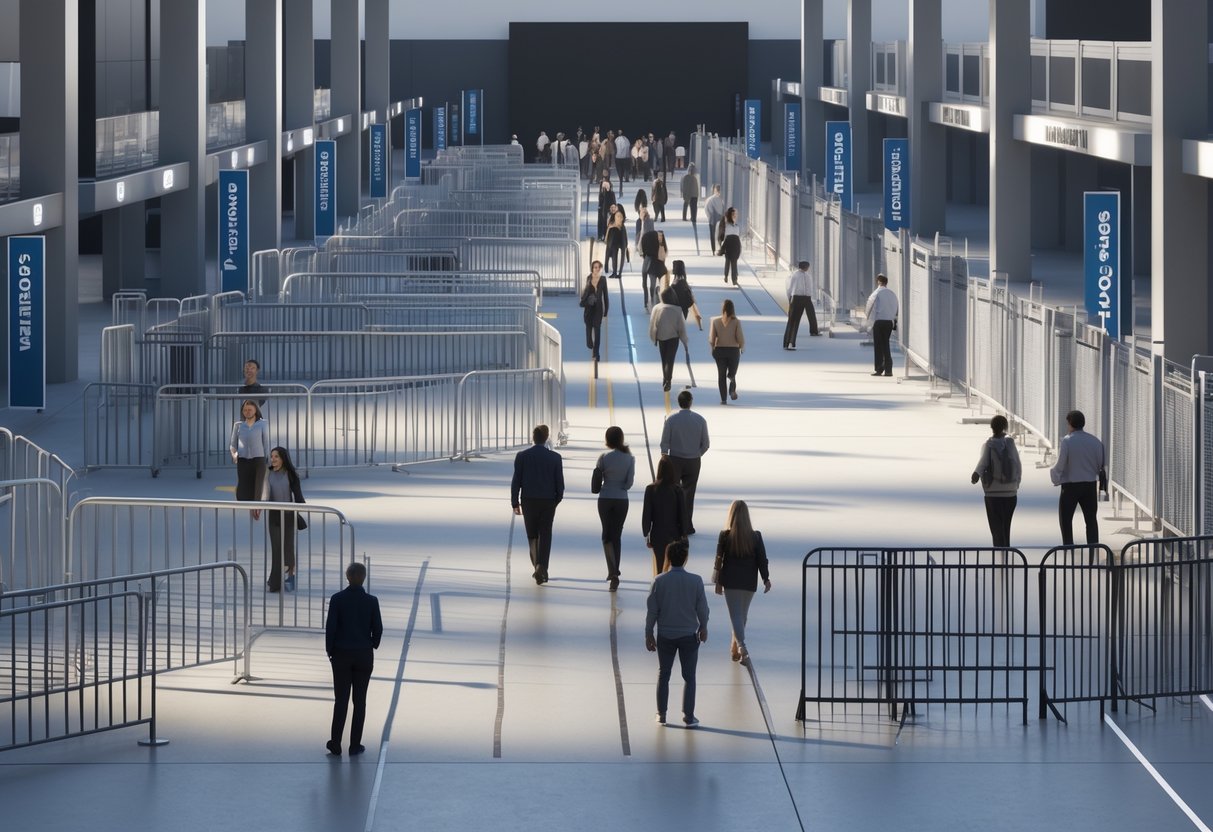
Physical barriers are the backbone of crowd control. They shape pathways and boundaries so people know where to go and where not to.
Where you put these barriers—and how you design entry and exit systems—decides how smoothly crowds move.
Types of Physical Barriers
We pick different barriers for each gaming event, depending on what we’re up against.
Stanchions and Rope Systems are a no-brainer for indoor esports events. They make tidy lines for merch stands or player meet-and-greets. Most places use retractable belts since they’re easy to move when the action shifts.
Metal Barricades come out for big outdoor gaming festivals. These tough, interlocking barriers can handle the crowd when fans surge toward the main stage.
Temporary Fencing secures VIP zones or player practice areas. You’ll often see six-foot panels separating competitors from the rest of the crowd at major tournaments.
Water-Filled Barriers are the heavy hitters for high-energy events. Conventions use them when they expect huge crowds around popular game demos or reveals.
Each type fits a different crowd size and energy level.
Placement Strategies for Optimum Crowd Flow
Good barrier placement stops bottlenecks, especially during peak times at gaming events.
We set up barriers to create natural flow channels so people move along clear paths. Angling barriers at 45 degrees (instead of straight lines) helps crowds turn corners without bunching up.
Queue systems work best when barriers snake around in a serpentine pattern. That keeps lines neat and makes the most of tight spaces near gaming booths or food vendors.
Leave enough room between barrier sections—three to four feet for regular flow, six to eight feet for emergencies. Gaming crowds can surge fast when matches end or exclusive content drops.
Sight lines really matter at esports events. Barriers should be low enough that people sitting down can still see the screens. Usually, 42 inches works for most setups.
Think about how people act, too. Attendees usually take the easiest path, so we design layouts that make the right routes obvious and the restricted areas less tempting.
Managing Entry and Exit Points
Entry and exit points need the most careful barrier setups since that’s where crowds get thickest.
Multiple entry lanes keep lines from getting dangerous outside before tournaments start. We usually plan one entry lane per 500 people, plus extras for VIPs and media.
Set up controlled exit plans so people don’t all leave at once when things wrap up. Sometimes we stagger exits by seating section or announce extra activities to spread people out.
Security checkpoints need barriers that make neat lines but still let staff see everything. Bag checks need space for gaming gear and merch.
Emergency exits should have barriers you can move or take down in a hurry. Use lighter, temporary options near these spots—not the heavy stuff.
Digital tools help manage barriers, too. QR code scanning or mobile check-ins can speed up entry and cut down on gate congestion. Big esports venues often mix tech with physical barriers for the best results.
Queue Management Techniques
When you set up queues well and use smart waiting systems, you keep crowds happy and safe. These days, the best queue management mixes physical barriers with digital solutions to cut wait times and stop bottlenecks before they start.
Organising Effective Queues
Physical queue design really starts with making clear pathways that people can follow without much thought. We set up barriers and put up signs so everyone knows exactly where to stand and move.
We place barriers in gentle curves, not sharp corners. People naturally follow these lines and don’t cut corners, which helps keep the flow smooth. Setting barriers about 1.2 metres apart gives folks enough space to move comfortably.
Clear directional signage is a must. We put signs every 10-15 metres along the route. Simple arrows and text like “Entry Queue” or “Food Stand – 5 minutes” work best—no one wants to stop and read a novel.
Multiple queue lanes make a huge difference in busy spots. We set up separate lanes for different ticket types or services. This way, people don’t get stuck in the wrong line and slow everyone down.
Staff members need to monitor queues in real time. We position crowd marshals at key points to help and redirect people when lines get too long.
Innovative Queuing Solutions
Digital systems now take over a lot of the heavy lifting in queue management. Mobile apps let people check wait times and book time slots before they even arrive.
Virtual queuing lets people join a line from anywhere. They get a notification when it’s their turn, so they don’t have to just stand around. This is a game-changer for popular attractions or food stands.
Electronic displays at each queue entrance show current wait times. We update these every few minutes so people can pick the shortest line. This helps spread the crowd out.
QR code systems make check-ins way faster. People just scan a code on their phones, skipping the hassle of paper tickets. Processing times drop by up to 60%, which is pretty impressive.
Timed entry tickets keep crowds steady. We sell tickets for specific time slots throughout the day, so people don’t all show up at once.
Reducing Wait Times and Enhancing Satisfaction
Queue entertainment really helps people stay happy while waiting. We install screens with event highlights or upcoming acts. Even some background music can make time pass a little faster.
Estimated wait time signs let people decide if they want to wait or come back later. We update these signs based on how long the lines actually are.
Express lanes help people with simple requests get through faster. We set up separate queues for folks who just need info or already paid.
Staff efficiency training matters at the queue endpoints. We train staff to handle common requests fast and call for help with the tricky stuff.
Queue feedback systems give us a chance to improve. We ask people about their wait through quick surveys or feedback terminals. Their input helps us tweak layouts and staff numbers for next time.
Comfort features make a big difference. We add shade, seating, and water stations near long lines. When people feel comfortable, the whole atmosphere improves.
Signage and Wayfinding Solutions
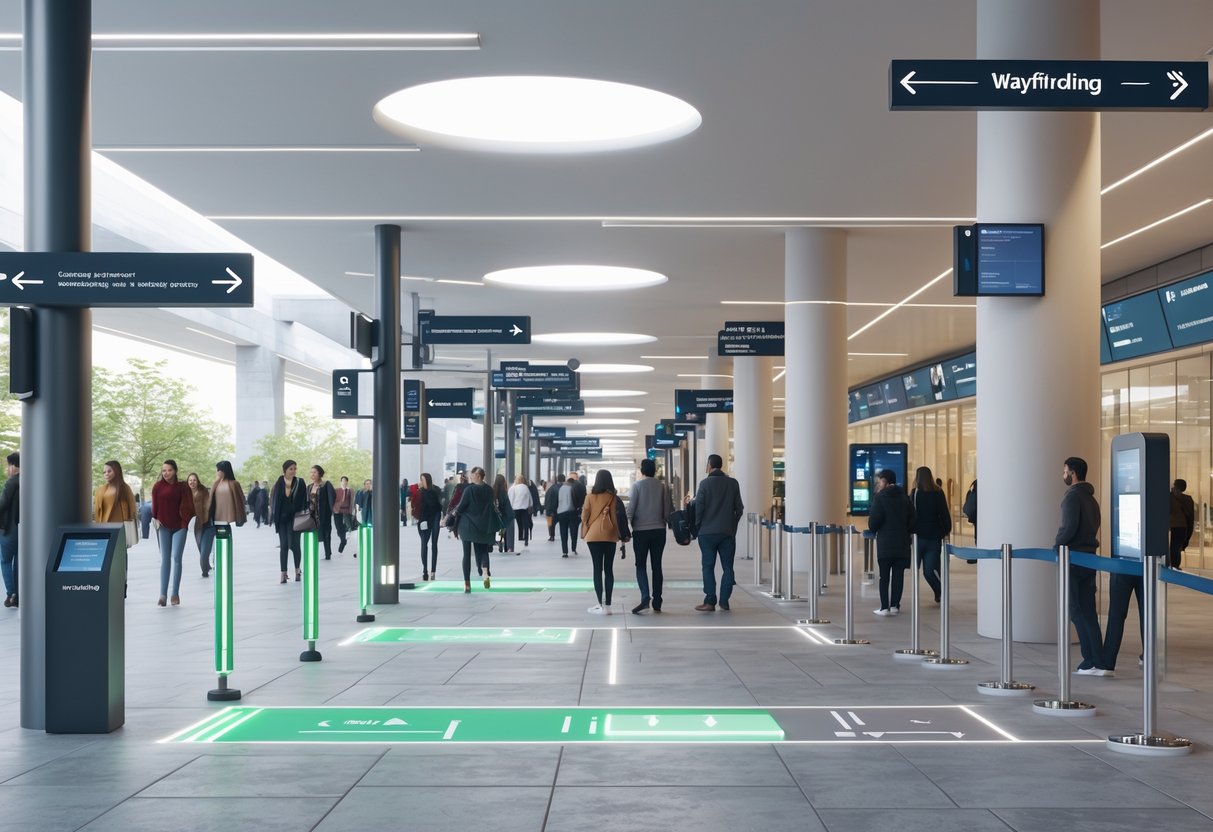
Effective signage guides crowds through spaces and cuts down on confusion. Digital displays now offer real-time updates that can change instantly if something unexpected happens.
Clear Visual Signage Practices
Placing signs in the right spots makes all the difference for crowd control. We put signs where people naturally pause and look for direction—no point hiding them in a corner.
Strategic positioning works best at entrances, exits, and big intersections. We keep signs at eye level, usually around 1.5 to 2 metres high.
The messaging needs to stay simple and direct. Large, bold fonts and high-contrast colours are key. We avoid cramming too much info on one sign.
Essential signage elements include:
- Clear directional arrows
- Simple words—no jargon
- Universal symbols when possible
- Consistent colour coding everywhere in the venue
Distance markers help people plan their route. A sign saying “5-minute walk to Exit B” sets realistic expectations.
For international events, multiple languages might be necessary. We keep translations accurate and use the same visual hierarchy for each language.
Implementing Wayfinding for Large Events
Large events need wayfinding systems that hold up under pressure. We start by mapping out how crowds naturally flow and where they might get stuck.
Hexagonal decision nodes work well in event spaces. These are spots where several paths meet, and people pause to figure out which way to go.
Colour-coded zones make navigation easier for everyone. We assign colours to different areas, like “Red Zone – Food Courts” or “Blue Zone – Main Stage.”
Key wayfinding components:
- Entry signage: Venue maps and emergency info right up front
- Pathway markers: Regular signs along the way for reassurance
- Destination signage: Final pointers to specific spots
- Emergency routes: Clearly marked exits and evacuation paths
Pre-event walkthroughs help us spot problem areas. We walk the space with fresh eyes and add signs where things feel confusing.
Staff stationed at big wayfinding points back up the signage, just in case someone needs a little extra help.
Role of Digital Signage and Real-Time Updates
Digital signage changes the game by adapting instantly to whatever’s happening. Unlike old-school signs, digital displays can switch from ads to emergency alerts in seconds.
Real-time updates make digital signage invaluable for crowd control. Schedule changes, capacity info, and safety announcements reach everyone all at once.
Interactive displays get people involved and provide info. Touch screens or kiosks help visitors find locations without flagging down staff.
Digital signage benefits:
- Instant updates: Change content remotely on all screens
- Queue management: Show live wait times to reduce frustration
- Emergency override: Push critical messages when needed
- Data collection: Analytics show which spots need attention
The tech connects with other systems for a full picture of what’s happening. Digital signs link to security cameras and monitoring software for better situational awareness.
Remote management lets us update displays from a central spot. We don’t have to send someone running around the venue with a USB stick.
Digital displays cut long-term costs compared to printed signs and give us way more flexibility for different events or last-minute changes.
Crowd Simulation and Monitoring Technology
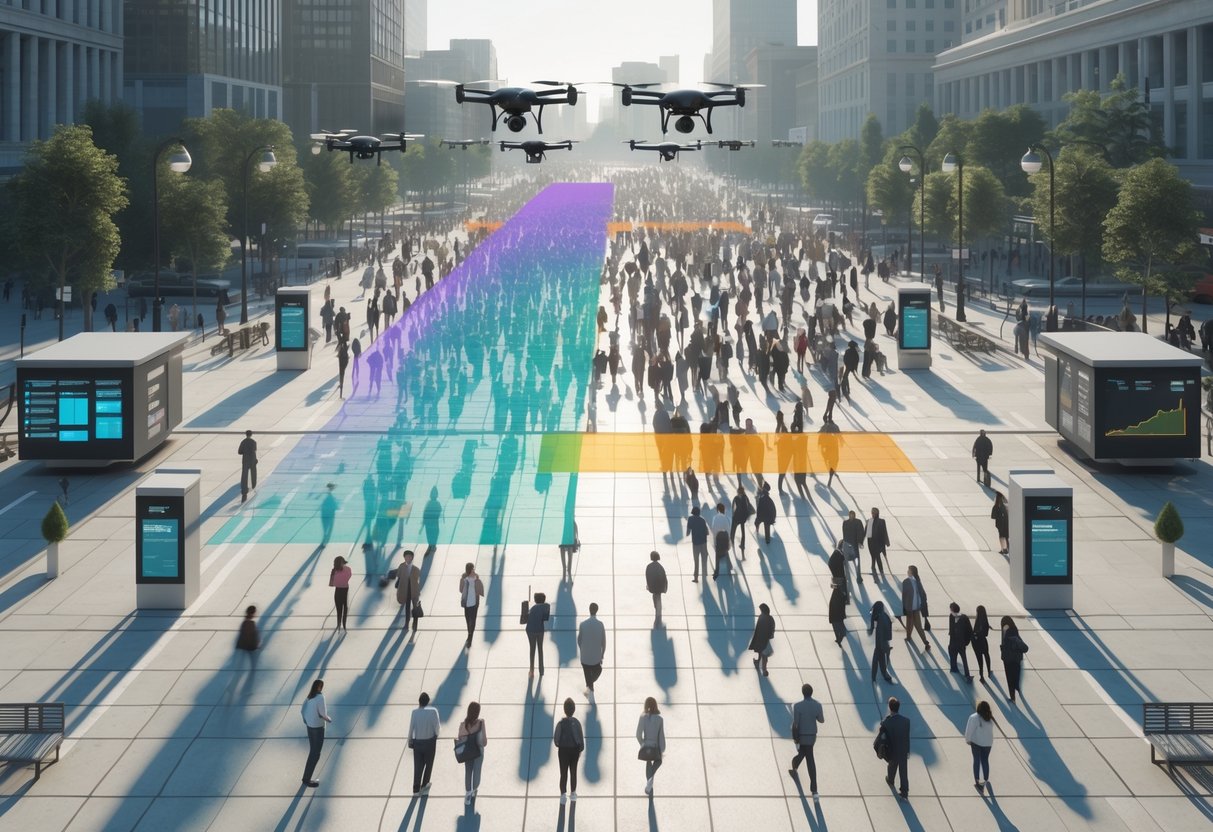
Modern crowd management relies on smart software and real-time monitoring tools to predict crowd behaviour and head off dangerous situations. Mobile apps now play a huge role in keeping attendees informed and helping organisers stay in control.
Crowd Simulation Software
Crowd simulation software gives event organisers a way to see how people will move through venues before the event even starts. These tools model crowd behaviour using factors like layout, entry points, and expected turnout.
The software highlights potential bottlenecks and dangerous spots. Organisers then use this info to redesign layouts and move barriers as needed. STEPS, MassMotion, and Oasys are some of the big names in this space.
Key features of simulation software:
- Predictive analysis of crowd movement
- 3D venue modelling
- Emergency evacuation planning
- Real-time adjustment recommendations
Most professional software costs anywhere from £5,000 to £50,000 a year. Smaller events can get by with more basic, affordable tools.
Event planners usually run multiple scenarios to test different layouts. This helps them pick the safest and most efficient option.
Real-Time Monitoring Tools
Real-time monitoring systems track crowd density and movement as the event happens. CCTV cameras with AI can count people and spot unusual patterns automatically.
These tools alert security teams when crowds get too dense. They also pinpoint areas where people slow down or gather unexpectedly.
Modern monitoring tools include:
- Heat mapping cameras that show crowd density with colours
- Automated counting systems that track ins and outs
- Predictive algorithms that forecast crowd behaviour 10-15 minutes ahead
- Integration platforms that pull data from multiple sources
Venues often use wireless sensors to back up the camera system. These sensors detect crowd pressure and movement in real time.
Security teams get instant alerts on their phones when things start to go wrong. This lets them react quickly before a situation gets out of hand.
Leveraging Mobile Apps for Control
Mobile apps give organisers a direct line to attendees during events. Push notifications can steer crowds away from busy spots in seconds.
Apps deliver real-time updates on queue times, facility status, and emergency info. Attendees can see crowd levels in different areas before moving.
Effective app features for crowd control:
- Live crowd density maps
- Alternative route suggestions
- Emergency alerts
- Digital queuing
Some apps use location tracking to monitor crowd distribution anonymously. This helps organisers decide when to open more exits or facilities.
Interactive features like digital programmes mean fewer info booths, which helps avoid congestion.
Apps also make two-way communication possible during emergencies. Attendees can report issues straight to security through the built-in chat.
Security Measures and Screening
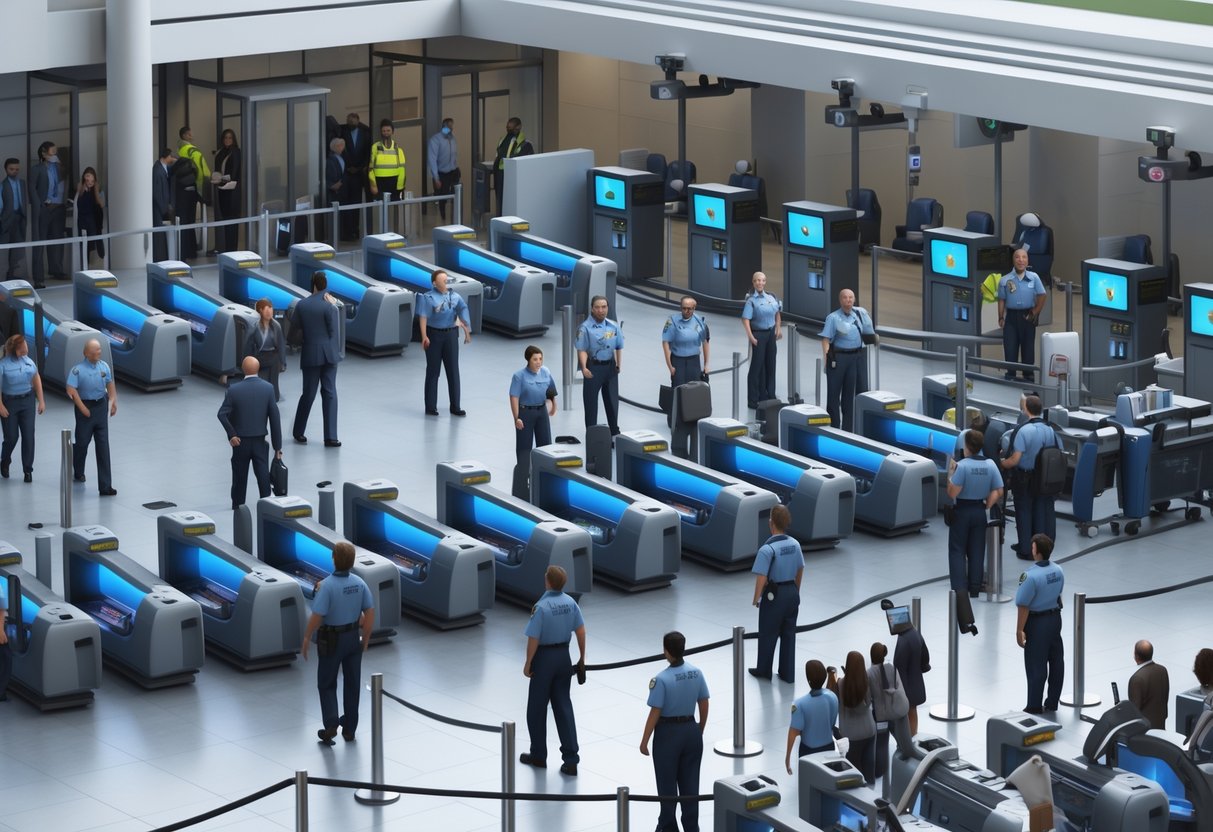
Effective security depends on several layers: advanced surveillance, thorough screening, and well-placed security teams. These elements work together to spot potential threats early and keep crowds safe.
Surveillance Cameras and Observation
Modern surveillance systems form the backbone of event security. We rely on high-def cameras in key spots to watch crowd behaviour and catch issues before they escalate.
We place cameras at entry points, busy areas, and any likely blind spots. Facial recognition technology helps security teams spot banned individuals or persons of interest fast.
Drone surveillance gives us aerial views of crowd density and movement. With this bird’s-eye view, operators can redirect crowds away from trouble spots.
Control rooms with multiple monitors let operators analyse footage in real time. Trained staff watch for odd behaviour, like someone moving against the flow or groups gathering in strange ways.
Data analytics now help predict crowd behaviour by tracking movement patterns. This tech alerts security teams to trouble spots before things get out of hand.
Mobile surveillance units can move as needed during events. These flexible systems adapt to changing crowd patterns and new security concerns.
Metal Detectors and Bag Checks
Metal detectors are the first line of screening at event entrances. We set them up at every entry to catch weapons and banned items.
Walk-through metal detectors process large numbers of people fast. Hand-held detectors give extra screening if someone sets off an alarm or needs a closer check.
Bag inspection backs up metal detection by catching non-metallic threats. Security staff check bags, purses, and personal items methodically.
| Screening Method | Speed | Detection Rate | Best Use |
|---|---|---|---|
| Walk-through detectors | High | 95% metals | Main entrances |
| Hand-held scanners | Medium | 98% metals | Secondary screening |
| Bag checks | Low | 90% all items | Thorough inspection |
X-ray machines scan bags without manual searches. These systems speed up entry while keeping security tight.
Trained staff know how to handle prohibited items. They keep situations calm and follow clear steps for anything suspicious.
RFID wristbands and ticket checks block unauthorised access. These tools make sure only legitimate attendees get in.
Visible Security Teams and Event Staff
Security teams stay visible throughout the venue, acting as both deterrents and first responders. Their presence reassures attendees and discourages troublemakers.
We place security staff at crowd density points, emergency exits, and high-risk zones. Teams keep in radio contact with central command to coordinate responses.
Event staff work with security to keep crowds moving smoothly. They answer questions, give directions, and spot problems early.
Plain-clothes officers blend in and watch behaviour discreetly. These undercover personnel can jump in quickly if something happens, without drawing attention.
Communication systems keep everyone in the loop. Digital radios with encryption ensure secure channels between teams.
Crowd psychology training helps security staff spot early signs of panic or aggression. Staff use de-escalation techniques to resolve conflicts peacefully.
Emergency response protocols assign clear roles for each team member during a crisis. Regular drills keep everyone ready for coordinated evacuations.
Specialised teams handle specific threats, like medical emergencies or VIP protection. This lets each team focus on what they do best.
Communication Systems and Information Dissemination
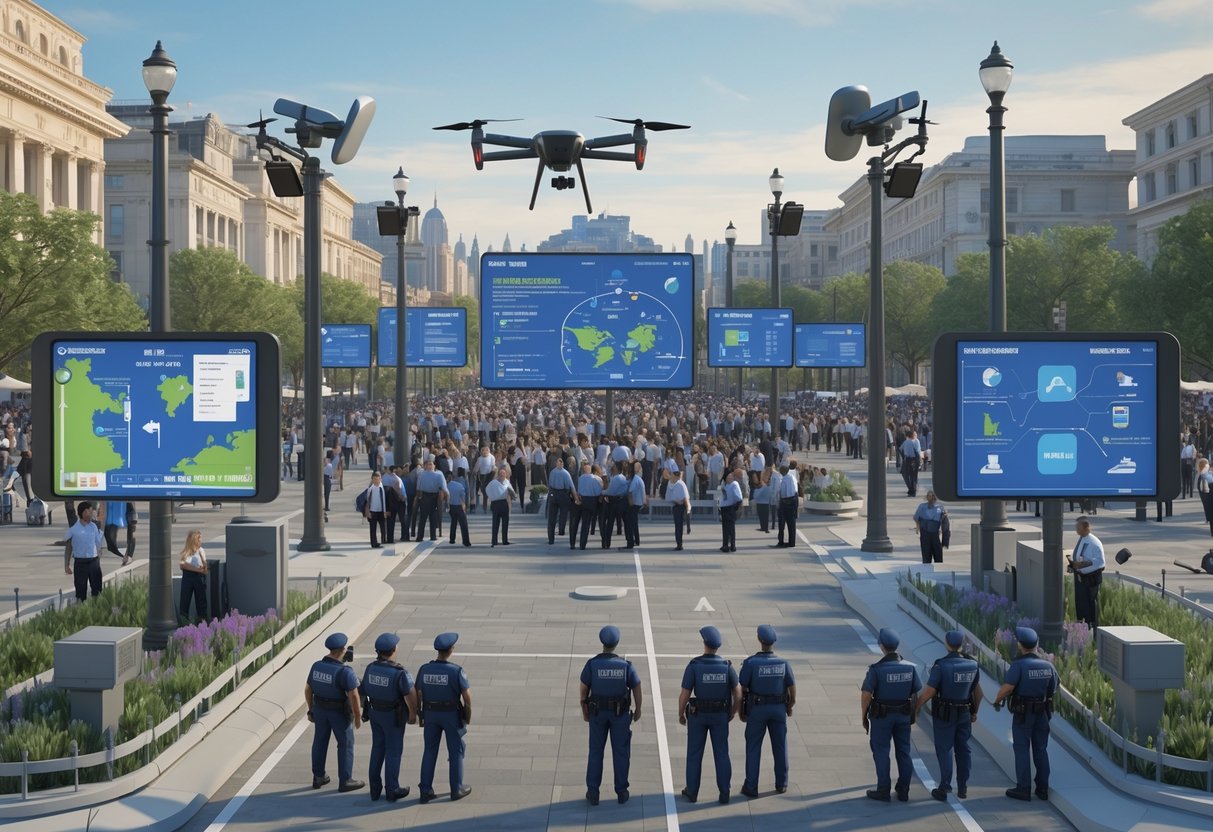
Clear communication honestly saves lives and keeps chaos at bay during events. We need reliable public address systems, organised team channels, and radios that keep working even when mobile networks drop out.
Effective Public Address Systems
Public address systems really are the backbone of crowd communication. They let you reach hundreds or even thousands of people in seconds with critical safety info.
Modern PA systems come with multiple microphones, amplifiers, and speakers you’ll find placed all over the venue. The trick is getting even sound coverage—nobody wants those annoying dead zones where you can’t hear a thing.
Emergency announcements work best when they’re clear and straight to the point. Pre-recorded messages for common situations like evacuations or weather delays save time and nerves. Staff can just hit a button and avoid scrambling for words when things get stressful.
Essential PA features include:
- Battery backup power for outages
- Weather-resistant outdoor speakers
- Multiple input sources (microphones, mobile devices, emergency alerts)
- Zone control to target specific areas
We always test PA systems before every event. That means checking sound levels, clarity, and making sure backup systems work. Some venues even run weekly tests to catch problems before they turn into headaches.
Internal and External Communication Channels
Event staff need their own communication channels, separate from public announcements. Internal systems help coordinate security, medical teams, and operations without sharing sensitive info with the crowd.
Internal channels typically include:
- Command centre coordination
- Security team updates
- Medical emergency alerts
- Logistics and crowd flow reports
External communication keeps us connected with emergency services, local authorities, and venue management. These lines stay open all event long for rapid response.
We supplement radio comms with digital platforms. Messaging apps or specialised software on smartphones and tablets keep everyone in the loop, let you share photos for incident reports, and update in real time.
Social media monitoring is a must. Staff watch event hashtags and local news feeds to spot issues brewing outside the venue before they spill over.
Staff Radio and Communication Devices
Two-way radios are lifesavers when mobile networks get overwhelmed by big crowds. Radios keep communication flowing even if everyone’s phone loses signal.
Radio system requirements:
- Sufficient channels for different teams
- Clear audio quality in noisy environments
- Long battery life (8-12 hours minimum)
- Hands-free operation options
We assign channels by function—security on one, medical on another, operations on a third. This keeps things organised and avoids chaos during emergencies.
Headsets matter, especially for staff who need hands-free operation. Security and crowd control folks get discreet earpieces so they can do their job without drawing attention.
We stay on top of battery checks and always have spare equipment ready. Charging stations and backup radios make sure no one gets stuck without a way to communicate.
GPS-enabled radios help supervisors track staff across massive venues. Instead of long explanations, you can just send help right where it’s needed.
Emergency Response and Contingency Planning
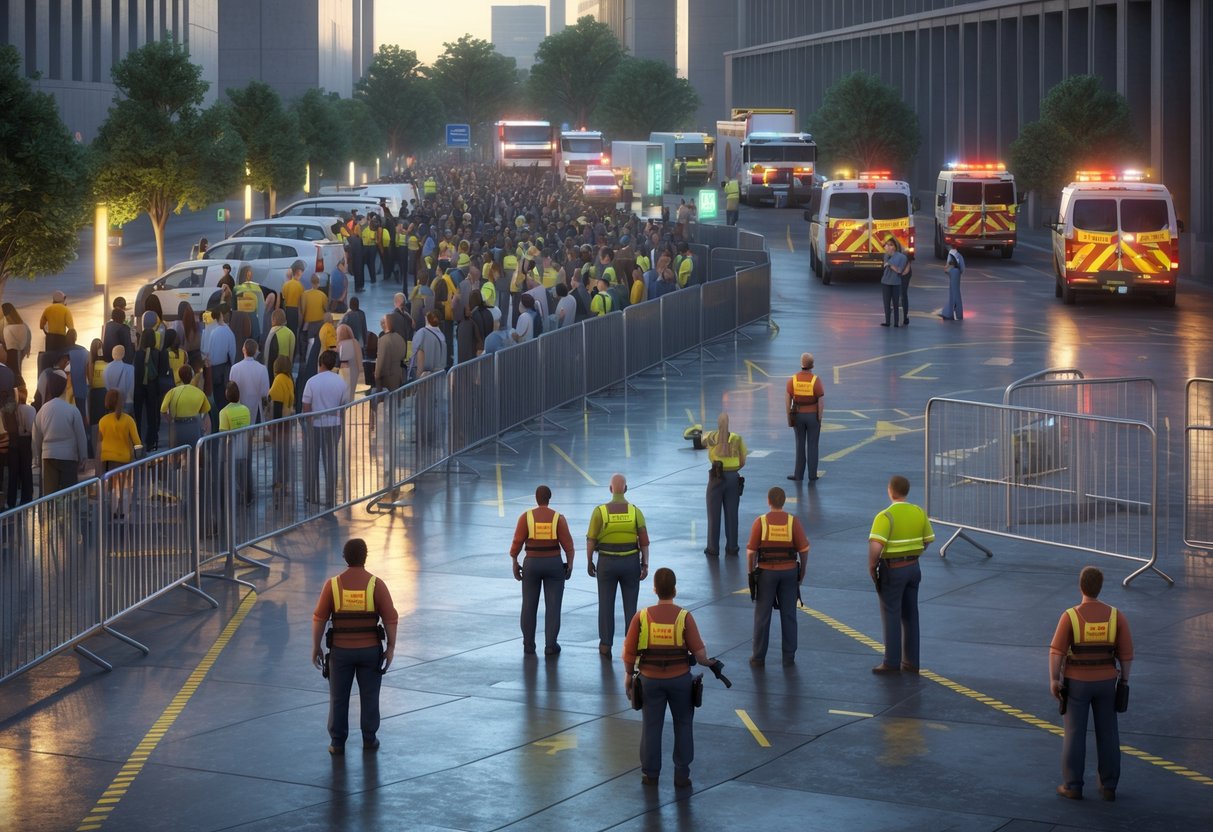
When crowds get out of hand, clear emergency protocols can make all the difference. Solid staff training and early coordination with local authorities set the stage for effective responses.
Rapid Evacuation Methods
Quick evacuation saves lives. We need clear exit routes with bright signs that people can see, even in bad lighting.
Phased evacuation works best for big crowds. Instead of letting everyone rush out at once, we guide sections to different exits. That stops dangerous pile-ups at doorways.
Key evacuation elements include:
- Multiple exit routes clearly marked
- Emergency lighting systems
- Public address systems for clear instructions
- Designated safe assembly areas outside the venue
Staff must know which exits to use for their area. We put trained people at each exit to guide the flow and keep panic at bay.
Emergency communication should stay short and direct. Use commands like “Walk calmly to the nearest exit.” Complicated instructions just confuse people.
Training for Emergencies
Good staff training keeps chaos in check. We train security teams on crowd psychology and how people react under stress.
Essential training topics cover:
- De-escalation techniques for angry or panicked individuals
- First aid and CPR certification
- Radio communication protocols
- Crowd movement patterns during emergencies
Regular drills get staff reacting fast, almost on autopilot. We run through different emergencies—medical, fires, security threats.
Training also covers spotting early warning signs. Staff learn to notice when people are getting squished or agitated before things go south.
Communication training makes sure everyone uses the same words and steps. When the whole team’s on the same page, response times get a lot better.
We update training programs regularly, using lessons from real events and best practices in the industry.
Coordinating with Local Authorities
We reach out to local emergency services well before the event. Police, fire, and paramedics all get involved at the planning stage, not just when something goes wrong.
Pre-event coordination includes:
- Sharing venue layouts and crowd capacity numbers
- Establishing direct communication channels
- Agreeing on response protocols for different emergency types
- Arranging on-site emergency service presence if needed
Joint planning sessions get everyone clear on their roles. Emergency services learn the venue, and our staff learn how to help pros do their job.
We hand over up-to-date contact info for key event staff—security chiefs, managers, organisers—so decisions happen fast.
Real-time communication during the event keeps authorities in the loop about crowd conditions. We report incidents right away, even if they seem small.
A designated liaison officer talks directly with emergency services. This keeps info flowing and avoids crossed wires.
Role of Ticketing Systems and Access Control
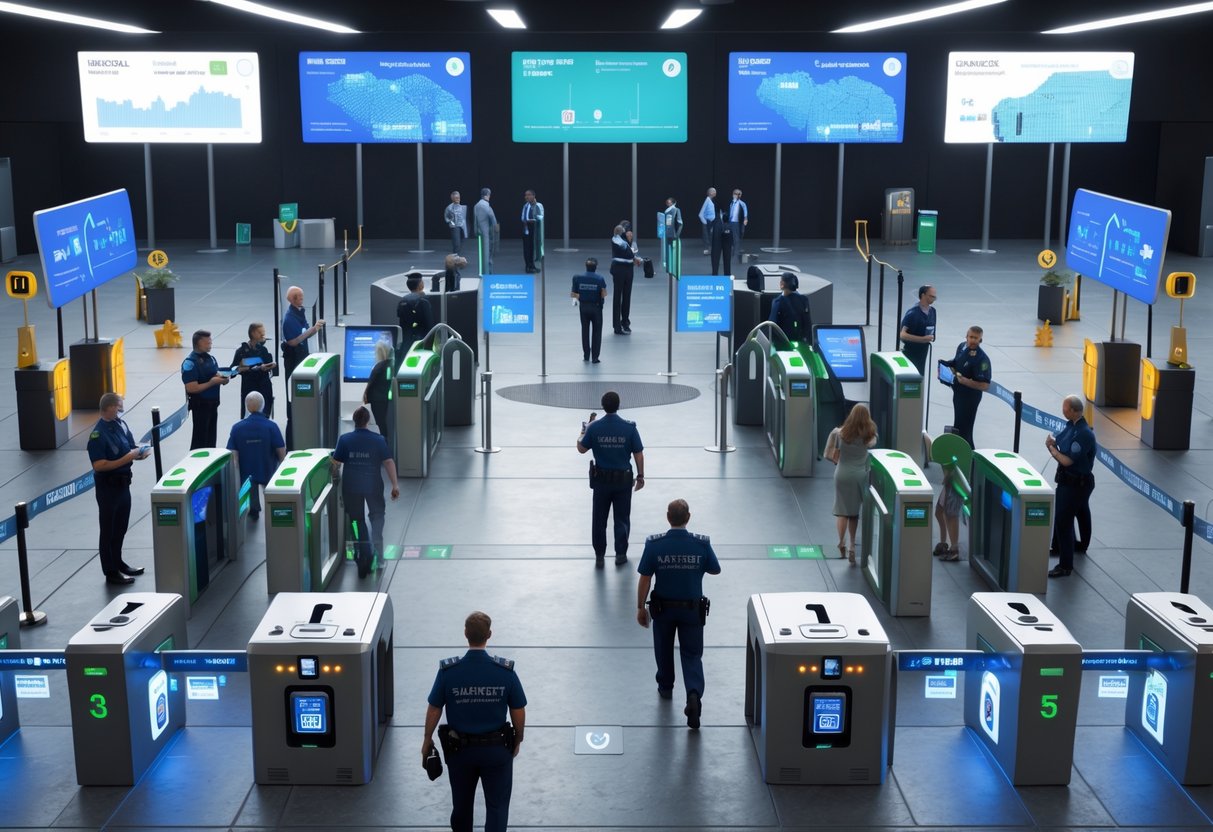
Modern ticketing systems and access control work hand-in-hand to manage crowds before the event even starts. Digital tools let organisers track attendance, check IDs, and separate guests into the right categories.
Digital Ticketing Solutions
Digital ticketing has pretty much replaced paper at big events. Mobile apps, QR codes, and RFID wristbands make getting in faster and cut down on fraud.
These systems link up with event management platforms. Organisers track attendance in real time and adjust security on the fly.
Key digital ticketing features:
- Mobile ticket delivery via email or apps
- QR code scanning for quick entry
- RFID wristbands for multi-day events
- Real-time attendance tracking
- Integration with payment systems
Digital ticketing also helps predict crowds. AI-powered tools look at past data to forecast attendance and help security plan staffing levels.
Contactless tech became a must after 2020. NFC-enabled devices and mobile tickets keep things moving and reduce physical contact in queues.
Access Verification and Scanning
Verification systems check tickets and stop unauthorised entry. Modern scanners spot fakes in seconds.
Barcode and QR code scanners are everywhere. Staff scan tickets and see guest info on handheld devices right at the door.
Verification technology options:
- Handheld barcode scanners
- Fixed scanning stations
- Mobile phone scanning apps
- Facial recognition systems
- Biometric verification
Advanced systems flag duplicates instantly. If someone tries to use a ticket twice, security hears about it right away.
Some events add facial recognition to ticket scanning. It’s extra secure for high-profile events, but you do have to think about privacy.
Database integration keeps all scans on record. Event managers watch entry patterns and spot security issues as they happen.
Managing Reserved and VIP Sections
Different ticket types need different access controls. VIPs, general admission, and staff all get their own entry points and checks.
Colour-coded wristbands or passes help staff spot who belongs where. VIP areas usually ask for photo ID on top of ticket scans.
Access control strategies:
- VIP Areas: Photo ID plus ticket verification
- General Admission: Standard ticket scanning
- Staff Areas: Special passes with photo identification
- Vendor Zones: Temporary access credentials
Physical barriers separate sections and keep people from wandering into the wrong area. Fencing and controlled entry points do the trick.
Security staff watch section boundaries all the time. They get training on access levels and how to check credentials.
Digital systems can revoke access instantly if needed. That way, ejected guests or cancelled passes get locked out right away.
Improving Attendee Experience and Customer Satisfaction
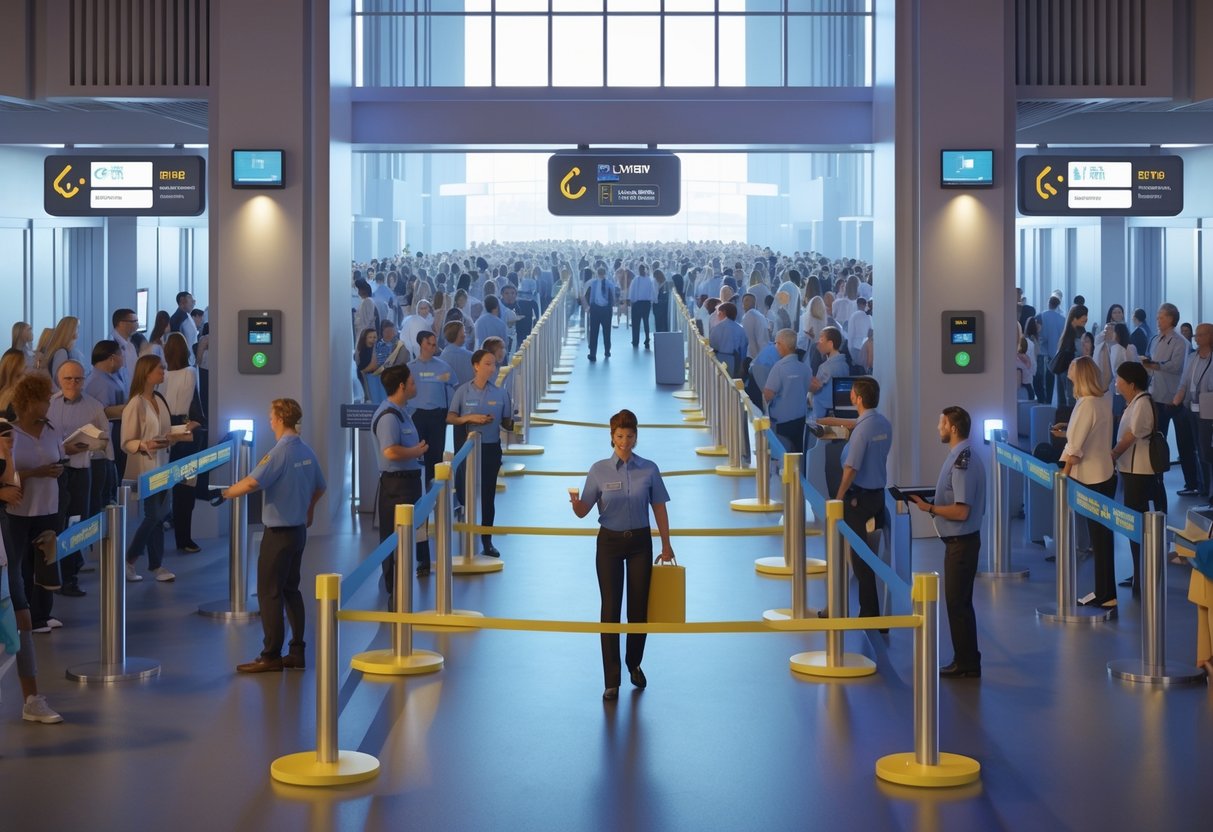
Good crowd control does more than just keep people safe—it actually boosts customer satisfaction. Shorter waits, better communication through apps, and easy feedback all help create memorable events.
Engaging Attendees Through Mobile Apps
Mobile apps have changed the game for esports tournaments and gaming events. They keep everyone updated on schedule changes, match results, and venue info—all in real time.
Key app features that improve experiences:
- Live updates on match delays or venue changes
- Interactive maps showing food stalls, toilets, and gaming zones
- Digital queuing for meet-and-greets with pro players
- Push notifications for emergency information
Instant alerts about crowded areas help reduce confusion. People appreciate getting nudged toward quieter spots through the app.
Quick win: Test your app weeks before the event. Slow load times or crashes during peak hours will drive people nuts.
Feedback Collection for Future Improvement
Getting feedback from attendees tells us what’s working and what needs fixing. Post-event surveys uncover pain points we might miss in the moment.
Effective feedback methods include:
| Method | Best For | Response Rate |
|---|---|---|
| QR code surveys | Quick venue exit feedback | 15-25% |
| Email surveys | Detailed experience reviews | 8-12% |
| Mobile app ratings | Real-time issue reporting | 20-30% |
Ask about specific crowd control stuff—queue lengths, sign clarity, staff helpfulness. Skip the generic satisfaction questions.
Warning: Keep surveys under 5 minutes. Anything longer and people just bail.
Balancing Safety with Comfort
We have to keep things safe, but attendees also want to feel welcome and relaxed. Over-the-top security can kill the gaming community vibe that makes esports events special.
What works?
- Visible but friendly security at entry points
- Clear explanations for bag checks and metal detectors
- Comfortable queuing areas with shade and seating
- Multiple exit routes clearly marked with gaming-themed signs
People feel better when safety measures make sense and aren’t too harsh. Staff training matters—a lot. Security teams need to get gaming culture and treat attendees with respect.
In practice: Teach security about gaming gear so they don’t hassle players carrying stuff like mechanical keyboards or gaming mice.
Frequently Asked Questions
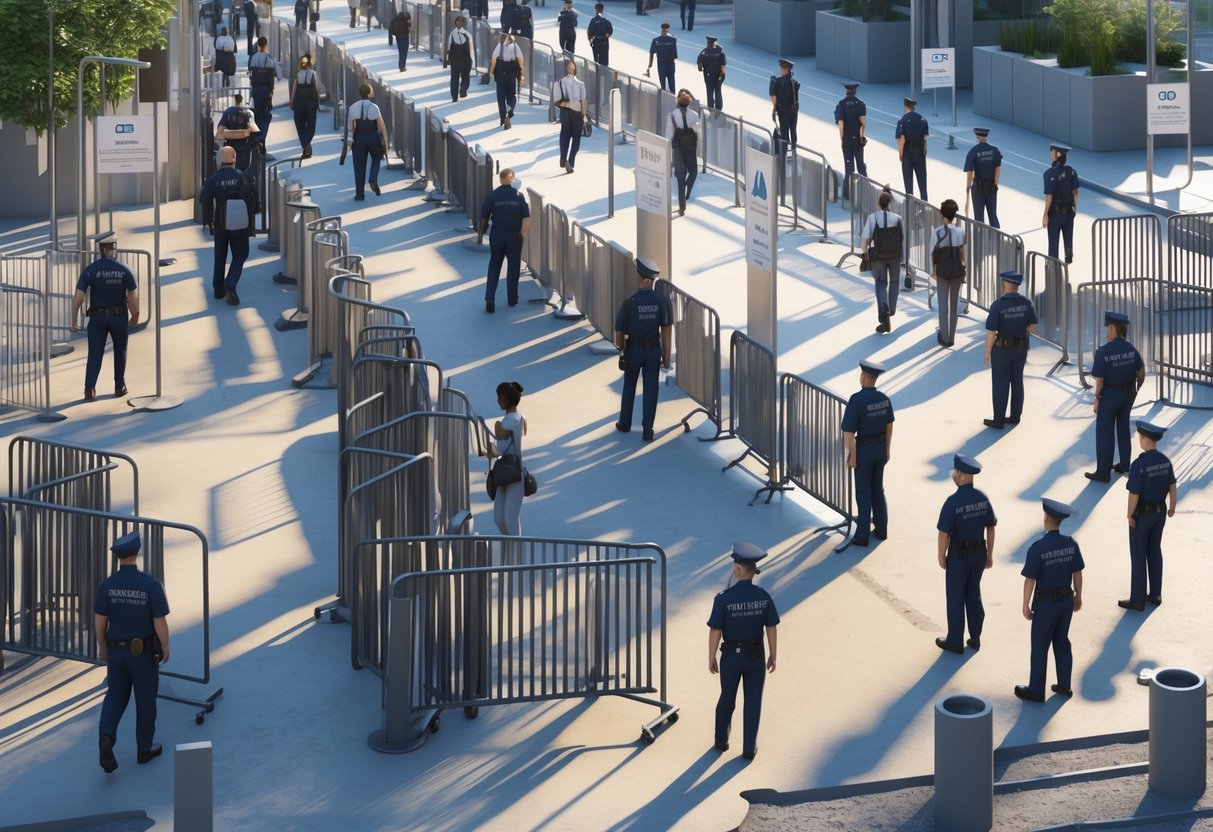
Managing crowds at esports events comes with unique challenges—excited fans, high-energy atmospheres, and digital queue management. Security pros need strategies that work for both online viewing parties and massive live competitions.
What are effective techniques for managing large crowds?
Barrier placement shapes the way crowds move. Set up barriers to form obvious lanes to entrances, exits, and hotspots like merch stands or food vendors.
Controlled entry points help regulate how many people enter at once. Use multiple access points and trained staff to avoid bottlenecks when crowds arrive.
Clear visual and audio communication keeps people informed. Digital displays with queue times or schedules help cut down on confusion and stress.
Trained staff stationed throughout the venue can spot trouble before it starts. Team members who understand crowd psychology and stay calm under pressure make a big difference.
Could you provide examples of successful crowd control at major events?
The League of Legends World Championship uses tiered entry with set time slots. That way, thousands of fans don’t show up all at once and overwhelm security.
DreamHack festivals use colour-coded wristbands for different access. Staff can easily tell who belongs in VIP or general admission.
ESL events rely on mobile apps for real-time crowd updates. People get notifications about queue lengths, schedule changes, and alternate routes to avoid bottlenecks.
Big esports venues like the O2 Arena use heat mapping technology. Security watches crowd density live and shifts staff to busy spots.
As a security guard, what strategies should I employ to manage crowds effectively?
Pick a spot where you can see how the crowd is moving. Watch for signs of frustration, excitement getting out of hand, or bottlenecks.
Talk to attendees clearly and calmly. Use simple directions like “please move to your right.”
Work as part of a team with radio comms. Share info about crowd movements and issues with other security staff right away.
Learn to read the mood at esports events. Fan reactions can shift fast from celebration to disappointment, and you’ll need to adjust your approach on the fly.
In what ways can one ensure order during an event with a high volume of attendees?
Set up multiple pathways for different needs. When you separate routes for entry, exit, toilets, and concessions, you keep people from bumping into each other.
Try staggering the timing of activities. If you schedule meet-and-greets, panel discussions, and tournament matches at different times, you won’t end up with everyone moving all at once.
Let technology help with queue management. Digital displays that show wait times make it easier for folks to decide when to jump in line.
Put staff at spots where people tend to gather or change direction. Team members at these key points can step in and offer guidance right when it’s needed.
What types of equipment are considered essential for maintaining crowd control?
Portable barriers make crowd management a lot more flexible. You can quickly move and connect these barriers as the crowd shifts during the event.
Equip your security team with two-way radios. With multiple channels, you can keep routine chatter separate from emergency updates.
Use digital signage to share real-time info with the crowd. These screens can update people on queue times, schedule changes, or emergency instructions.
Set up crowd monitoring cameras to keep an eye on the big picture. Place them at entrances, main gathering spots, and anywhere you think a bottleneck might pop up.
Can you list the different types of crowd control methods used in security management?
Physical barriers can be permanent, like railings, or temporary, like rope barriers or metal fencing.
Security teams use these in different ways, depending on the size of the crowd or how the event is set up.
Trained security guards, volunteers, and event staff handle personnel-based methods. You’ll often see them stationed at key spots throughout the venue.
These people can react quickly and adapt to whatever happens on the ground.
Technology plays a big role too. Crowd monitoring systems track movement, while mobile apps help keep attendees in the loop.
Automated entry systems can speed things up and keep things organized.
Communication methods matter just as much. Event organizers rely on public address systems, digital displays, and even social media updates.
By using several channels, they make sure everyone gets the message, even if things get hectic.

